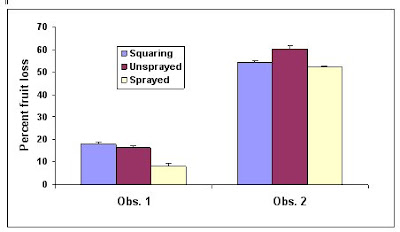With the Festive Season almost here and an irrigation pending, is there value in applying a spray for mirids for peace of mind? This decision to apply an insurance spray needs to be carefully considered because it has the potential to cost much more in the long run.
Where do mirids come from?
Mirids overwinter as adults on wild hosts. In the spring with rising temperature, mirid populations start to build up on alternative hosts around cotton growing areas. Wet winters usually contribute large reserves of alternative hosts which support mirids. Once these hosts hay off and lose their suitability, the mirids can invade seedling or squaring cotton. Mirids sometimes build up in western Queensland, from where they allegedly move on north-westerly winds and invade cotton areas. Mirid adults also continually move into cotton from surrounding hosts and move out of the cotton to alternative hosts throughout the season.
In order to make this decision, we need to understand the population dynamics of mirids, their damage potential and what is currently happening to the crop.
What is happening this year?
Although the past winter was relatively wet, mirid numbers have been very low across the cotton growing areas so far this year. The reason for this phenomenon is not well understood. It could be that alternative hosts are still fresh enough to continue to support mirids, or the severe and prolonged winter may have had a detrimental effect on mirid populations.
Do we need to be worried about square loss at this stage?
If square retention is above 70% and mirid numbers are very low (as is the case for many crops this year), there is no need to be unduly concerned. Squares may be lost for various reasons e.g. insect feeding and physiological reasons.
If mirid numbers are very low and retention is less than 70%, square loss may be due to reasons other than insect feeding and a spray will not help. Square loss at this stage will be compensated fully provided plants do not further suffer from water or nutrient stress or from any other insects.
Figure 1. Compensation for mirid damage at squaring stage
Figure 1 shows plant mapping data in Bollgard® II..
Observation 1 shows the percentage fruit loss for 3 treatments at the squaring stage while observation 2 shows the same 3 treatments at cut out. The treatments consisted of the following:
In treatment 1 (blue) plants were sprayed on a regular basis starting from when 60% of plants had their first flower until cut out. Treatment 2 (red) was not sprayed for mirids at any time during the season. Treatment 3 was sprayed regularly throughout the season to provide total protection against mirids
In observation 1 – the squaring stage – there is a significant difference between treatment 1 (sprayed from squaring) and treatment 3 (sprayed all season) with 18% fruit loss for treatment 1 and 8% loss in treatment 3.
Consequences of unwarranted mirid sprays at this stage
There are several consequences of an insurance spray.
– It is an unnecessary expense.
– Disruption of benefcial communities at this early stage could flare secondary pests such as aphids, mites and whitefly.
– Sprays at this stage, whether high or low rate, will not provide long residual protection. Mirids could move in from alternative hosts at any time, and it is best to save the spray for when it is really warranted.
Article by Dr Moazzem Khan
However if we now look at what happened in these treatment at cut out, we find that there is no significant difference between treatment 1 and 3. What this shows is that in this experiment the plants had the ability to make up for the early season fruit loss.


